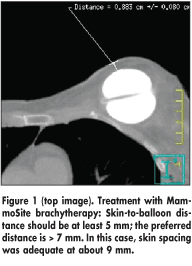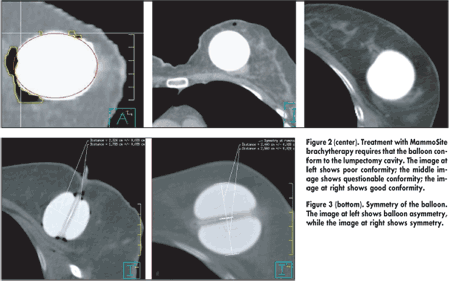Lessons From Ongoing Clinical Experience With MammoSite Breast Brachytherapy
Accumulating clinical experience with MammoSite breast brachytherapy is supporting its safety, efficacy, and good cosmetic outcomes, while also providing lessons to improve its use, according to a pair of studies presented at the 47th Annual Meeting of the American Society for Therapeutic Radiology and Oncology
DENVERAccumulating clinical experience with MammoSite breast brachytherapy is supporting its safety, efficacy, and good cosmetic outcomes, while also providing lessons to improve its use, according to a pair of studies presented at the 47th Annual Meeting of the American Society for Therapeutic Radiology and Oncology (ASTRO).
Martin Keisch, MD, medical director of radiation oncology, Cedars Medical Center, Miami, presented updated data from the original cohort trial conducted to obtain Food and Drug Administration approval for the MammoSite device (abstract 10). To be eligible for the trial, patients had to be at least 45 years old; have T1N0 cancers, a lumpectomy cavity size of 3 cm, and no tumor on inked margins; and have undergone their final surgery no more than 10 weeks earlier.
"The critical criteria from a technical perspective included skin-to-balloon distance, balloon-cavity conformance (that is, the surface of the balloon was in contact with the lumpectomy margin), and that the balloon was symmetrical," Dr. Keisch said.
In the trial, 43 patients received brachytherapy (34 Gy given in 10 fractions over 5 treatment days). The balloon was placed at the time of lumpectomy in 25 of these patients and after lumpectomy, as a closed procedure, in 18 patients.
A total of 40 patients agreed to follow-up, and the updated data were obtained at a median follow-up of 48 months (range, 28 to 62 months), Dr. Keisch said. None of the patients have experienced a recurrence. "There is no question that these patients are still within a window where we could anticipate a local recurrence," he acknowledged. "The plan is to follow them out to 10 years."
Cosmetic outcomes have been stable over time, Dr. Keisch said, with excellent to good results noted in 88% of patients in 2004, 84% in 2005, and 80% at this most recent follow-up. "The median skin spacing continues to be significantly different in those patients having a good to excellent cosmetic outcome vs a fair cosmetic outcome. It's really a surrogate for dose," he noted. The proportion of patients with good or excellent cosmesis was significantly higher among those whose skin spacing was 8 mm or greater than among those with skin spacing of 5 to 7 mm (89% vs 58%). In contrast, a variety of other factors (timing of implantation, balloon volume, breast size, receipt of chemotherapy, and age) were not associated with cosmetic outcome.
There have not been any adverse events requiring intervention, Dr. Keisch said. Moreover, none of the patients have developed symptomatic fat necrosis, and only 8% have developed asymptomatic fat necrosis. Moderate proportions of patients have experienced cosmetic complications: focal telangiectasias (40%), localized fibrosis (35%), and localized breast tissue retraction (12%).
Two of these cosmetic complicationstelangiectasia and tissue retractionwere associated with skin spacing, whereas fibrosis was not, Dr. Keisch noted. The incidence of telangiectasia was significantly higher when skin spacing was 5 to 7 mm than when it was greater than 7 mm (67% vs 29%, respectively); in addition, median skin spacing was significantly less in patients who developed telangiectasias than in their counterparts who did not (7.5 vs 11.5 mm). Similarly, there was a trend toward a higher rate of tissue retraction among patients with skin spacing of 5 to 7 mm than among patients with spacing of greater than 7 mm (25% vs 7%), and median skin spacing was significantly less in patients who developed tissue retraction than in those who did not (7 vs 10 mm).
At last follow-up, all patients reported that they were satisfied with their treatment and would recommend it to their friends and family, Dr. Keisch said. Noting that this was the very first group of patients in which MammoSite was tested, he commented that increasing experience with the applicator is improving its use, for example, making the need for balloon explantation rare today. "I think we have learned a lot," he concluded.
Institutional Cohort
Sushil Beriwal, MD, medical director of Radiation Oncology, University of Pittsburgh Cancer Institute, presented findings from the first 100 patients treated at the institute with MammoSite brachytherapy (abstract 11). The patients underwent treatment between June 2002 and October 2004; to be eligible, they were required to be candidates for breast-conserving surgery, and to have a tumor diameter of 3 cm or less, surgical margins of 2 mm or more, and preferably node-negative disease.

The balloon was placed with an open technique in 81 patients and with an ultrasound-guided closed technique in 19 patients. "Thirty-five of these patients did have ellipse skin excisions to facilitate the placement of the MammoSite catheter. This was done for tumors that were more anteriorly located, to get good skin-to-balloon distance," Dr. Beriwal explained.
All patients underwent CT imaging to measure balloon diameter and to confirm adherence to three strict inclusion criteria, he said. The first was adequate skin spacing, defined as at least 5 mm but ideally more than 7 mm (see Figure 1). The second was adequate conformity of the balloon to the lumpectomy cavity, assessed subjectively and, in questionable cases, objectively; by objective assessment, conformity was acceptable if the percentage of air and seroma with respect to PTV (planning target volume) was less than 10% (see Figure 2). The third was adequate symmetry of the balloon, defined as achievement of radial measurements within 2 mm of each other (see Figure 3).

The balloon had to be removed in 14 patients, most often because of inadequate skin spacing and occasionally because of poor conformity or adverse pathologic findings. The remaining 86 patients received 3.4 Gy twice daily for 10 fractions, prescribed to a 1-cm depth from the balloon surface. All were given antibiotics prophylactically during their treatment and were assessed at 1 week, at 1 month, and every 3 months thereafter. Nine patients received systemic adjuvant chemotherapy.
In most patients, tumor diameter measured less than 2 cm, and the median diameter was 1 cm, Dr. Beriwal noted. About 5% of the 86 treated patients had node-positive disease, with involvement of only a single node in all cases. Most patients (92%) had infiltrating ductal carcinoma, but 2% had ductal carcinoma in situ, 2% tubular carcinoma, and 3% infiltrating lobular carcinoma. Skin spacing was 5 to 6.9 mm in 6% of patients, 7 to 9.9 mm in 17%, and 10 mm or greater in 77%. Median follow-up has been 12 months (range, 3 to 30 months).
In terms of acute complications, six patients (7%) experienced balloon rupture necessitating replacement; of these six patients, two had multiple ruptures, one of whom discontinued brachytherapy and completed treatment by external-beam radiation therapy, Dr. Beriwal said. "These ruptures were because of the suture rubbing up against the balloon," he noted. In addition, 40% of patients had a palpable seroma, 28% experienced grade 1 or grade 2 dermatitis, 12% developed wound infection, and 2% developed an abscess and had to undergo incision and drainage.
In terms of later complications, 22 patients (26%) had persistence of a palpable seroma beyond 6 months; of these 22 patients, 7 underwent aspiration of the seroma because of symptoms, 2 of whom developed an abscess and had to undergo incision and drainage.
In addition, among the nine patients given systemic chemotherapy, one developed radiation-recall dermatitis and one developed fat necrosis.
Overall, the cosmetic result was rated excellent in 56% of patients, good in 37%, and fair in 7%, Dr. Beriwal said. Among the five patients with skin spacing of less than 7 mm, four had good to excellent cosmesis, while one had fair cosmesis. And among the 35 patients who had an elliptical skin excision, 20 had an excellent result, while 15 had a good result.
Summing up the findings, Dr. Beriwal commented, "Acute toxicity in our experience was similar to what is reported in the MammoSite brachytherapy registry trial." However, he noted, the rate of seroma formation was comparatively higher.
"Persistence of seroma in this setting may be attributed to high radiation doses to the surgical cavity margin, which may induce fibrosis and thus interfere with the process of normal involution," he said. Dr. Beriwal recommended that "seroma, unless symptomatic, should not be aspirated," because of the risk of infection.
Newsletter
Stay up to date on recent advances in the multidisciplinary approach to cancer.